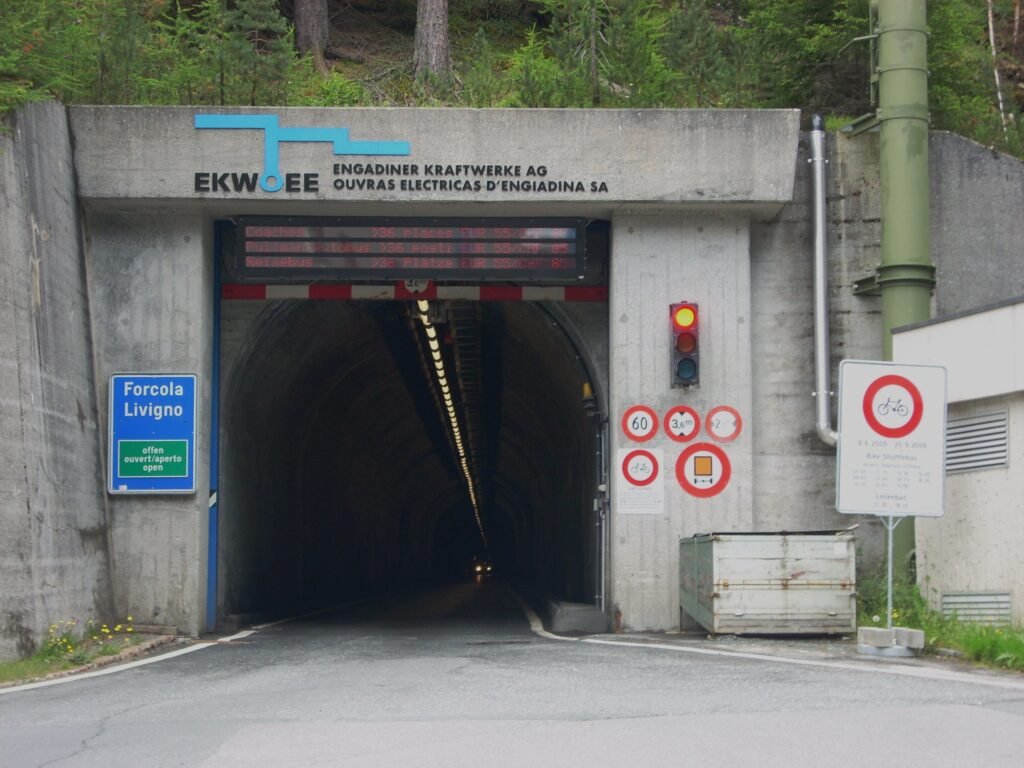Special Tolls for Passing Through Tunnels
In addition to the standard motorway vignette required for using motorways in Switzerland, there are certain sections where special tolls are collected for tunnel passage. These tolls are implemented to ensure safety, and manage traffic flow, especially in areas with challenging terrain.

Munt-la-Schera Tunnel
Located in the remote Engadin region, the Munt-la-Schera Tunnel serves as a crucial route between Switzerland and Italy, specifically for travelers heading to the popular Livigno area. This tunnel is unique because it is narrow and operates as a one-way tunnel. Due to its one-way nature, traffic schedules and toll rates may vary depending on the time of day and the direction of travel. This tunnel also serves an important function for local residents and businesses, who rely on it for essential travel and transport of goods.
Munt-la-Schera Tunnel

Summer Tariff (May-November)
Passenger Vehicle Up to 9 Seats
One Journey
15 ₣ / 16 €
Return Ticket
17 ₣ / 18 €
Motorhome/Caravan
One Journey
23 ₣ / 24 €
Return Ticket
41 ₣ / 43 €
Motorcycle
One Journey
11 ₣ / 11.50 €
Return Ticket
17 ₣ / 18 €
Winter tariff (December – April)
Passenger Vehicle Up to 9 Seats
One Journey
Sunday to Friday: 20 ₣ / 21.50 €
Saturday: 29 ₣ / 31 €
Return Ticket
Sunday to Friday: 35 ₣ / 37.50 €
Saturday: 42 ₣ / 45 €
Motorhome/Caravan
One Journey
23 ₣ / 24 €
Return Ticket
41 ₣ / 43 €
Motorcycle
One Journey
11 ₣ / 11.50 €
Return Ticket
20 ₣ / 21.50 €
Great St. Bernard Tunnel
The Grand St. Bernard Tunnel is a key connection between Switzerland and Italy, linking the Valais region with the Aosta Valley. Known for its relatively high tolls. The tunnel spans approximately 5.8 kilometers (about 3.6 miles) and is open year-round.

Passenger Vehicle (with or without trailer)
One Journey
31 ₣ / 32.50 €
Return Ticket
50 ₣ / 52 €
Motorhome/Caravan
One Journey
48.50 ₣ / 55.50 €
Return Ticket
77.50 ₣ / 81 €
Motorcycle
One Journey
18.50 ₣ / 19.50 €
Return Ticket
24.50 ₣ / 25.50 €
Current Situation on Swiss Motorways and Tunnels
As of 2024, Switzerland continues to invest in its motorway and tunnel infrastructure to handle growing traffic demands and maintain safety standards. The government is focused on several key areas, including the modernization of existing tunnels to meet updated safety regulations, expansion of motorway capacity to alleviate congestion, and the introduction of new technologies such as smart traffic management systems.
Additionally, several infrastructure projects are underway or in planning stages, aiming to improve connectivity and reduce bottlenecks. For example, there are ongoing discussions about expanding certain motorway sections and constructing new bypasses around heavily congested areas. There is also a significant push toward sustainability, with initiatives to promote electric vehicle use and improve charging infrastructure along major routes.

